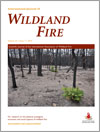International Journal of Wildland Fire
Volume 23
Number 7 2014
Very large wildfires have lasting ecological and social effects. They account for a substantial portion of annual area burned. Although relationships between climate and annual area burned have been studied, there remains a need to understand specifically how climate drives these individual events in order to manage for their effects.
Simulation of future climate and forest management actions using the Climate–Forest Vegetation Simulator showed long-term effects of wildfire and management decisions. Severe climate change led to a transformation to pinyon–juniper woodlands, but ponderosa pine forests could persist through moderate climate scenarios under uneven-aged and prescribed fire management.
We examined post-fire assessment and treatment implementation reports from wildfires on National Forest lands in the western US that occurred between 1972 and 2009 to determine decadal changes in fire characteristics, types of post-fire treatments used and the justifications and expenditures for these treatments.
We present a procedure that allows calibrating the Fire Weather Index for fire danger rating over Mediterranean Europe. The procedure is based on probabilities of fire duration as estimated from generalised Pareto models resulting from integrated use of vegetation cover databases, weather data and fire activity as detected by remote sensing from space.
We investigated the influence of broad- v. fine-scale factors on fire on three parallel mountains in north-eastern Mexico. Despite similar fire regime attributes, we found low fire synchrony among mountains, suggesting strong fine-scale influence on fire occurrence. Our results highlight the importance of scale in describing fire regimes.
Two newly developed models for simulation of near surface wind are presented and compared against measurements of wind flow. The comparisons suggest that the more complex model best matches measurements; however, the less complex model runs much faster and in some cases may provide more rapid information to fire managers.
This work explores how three different methods for producing high resolution wind information affects fire spread simulations. The results indicate that a momentum based wind model that accounts for turbulence provides the most accurate fire growth simulations. However, fire growth based on a simpler mass based conservation model is much better than no fine scale wind model at all.
A one-dimensional, finite-length scale, transient heat conduction model was developed and combined with an inexpensive, thermocouple-based aluminium sensor to create a rapidly deployable, non-cooled sensor for measuring incident heat flux from wildland fires.
The effect of ecosystem stage after land abandonment on post-fire plant recovery was evaluated in a Mediterranean mountain terraced landscape. The studied successional stages (dry grassland, dense shrubland and pine stands) significantly influenced fire severity and post-fire vegetation recovery. The pine stands showed the greatest vulnerability to fire.
We analysed the applicability of using high-resolution photographs of understorey vegetation to characterise fuel types (e.g. grasses, pine litter), and how these fuel types and their relative biomass related to thermal imagery of fire. We illustrated how fuel and fire variability at sub-metre scales are important in frequently burned ecosystems.
Pyrogenic carbon deposited as a by-product of prescribed fire is a complex substrate when added to soil. Interactions between pyrogenic carbon and soil microbial processes are complex and associated with changes in both carbon and nutrient availability, and associated shifts in pH.
We conducted a systematic review of the effect of fire on 122 small mammal species. We found that survey design and statistical analysis was often inadequate and therefore limited inference. The overall effect size between unburnt and burnt sites was relatively small but was influenced by body size and habitat preference of species.




